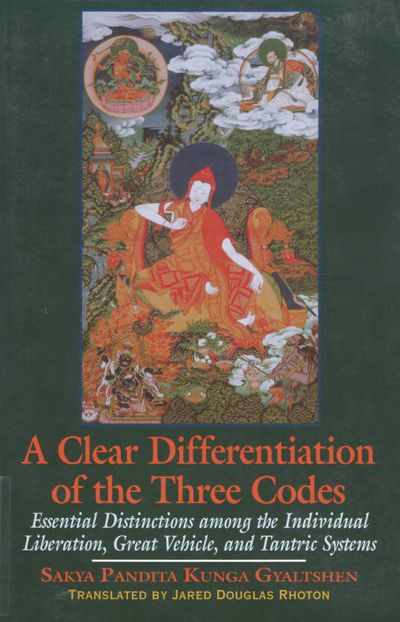A Clear Differentiation of the Three Codes
< Books
| Line 8: | Line 8: | ||
|FullTextRead=No | |FullTextRead=No | ||
|TextTranslated=Texts/Sdom gsum rab dbye | |TextTranslated=Texts/Sdom gsum rab dbye | ||
| − | |BookEssay=Tibetan Buddhists often describe their religion, and the path of practice it teaches, in terms of "three vows" | + | |BookEssay=Tibetan Buddhists often describe their religion, and the path of practice it teaches, in terms of "three vows" (''sdom gsum'')-namely, the three codes of discipline associated with the monastic traditions of the Vinaya, the progressive path of the bodhisattva, and the esoteric precepts of the tantras. Mastery of the three codes implies broad and deep scriptural learning as well as scrupulous attention to every detail of one's personal conduct and deportment. For such mastery to be recognized means the achievement of an authoritative status within the religious community. Hence, in the Tibetan Buddhist tradition, the three codes were subject to intensive scrutiny and became a focal point of sustained commentary and debate. |
| − | Among the many works of Tibetan masters devoted to the three codes, none | + | Among the many works of Tibetan masters devoted to the three codes, none has enjoyed more notoriety than ''A Clear Differentiation of the Three Codes'' (''sDom pa gsum pi rab tu dbye ba'') by the celebrated author Sakya Pandita Kunga Gyaltshen (or Sapan, n82-I251), presented here in a Western translation for the first time. Not so much a text on the content of the codes themselves as an examination of the many particular questions that relate to the codes-questions that Sapan saw as subject to misunderstanding on the part of his Tibetan contemporaries- The Three Codes has a strongly polemical character. Thus it is easy to see why some readers found the work objectionable in places, others praised it, and all became fascinated by it. Few indigenous Tibetan writings have inspired so abundant and diverse a body of later commentary, commentary that rivals even that on the great Indian Buddhist treatises in its extent. |
| − | has enjoyed more notoriety than A Clear Differentiation of the Three Codes | ||
| − | Whatever one may conclude about the correctness of Sakya Pandita's opinions | + | Whatever one may conclude about the correctness of Sakya Pandita's opinions on any given topic, there can be no doubt that by raising so many questions so trenchantly, Sapan roused Tibetan Buddhists from doctrinal complacency and contributed mightily to the formation of the remarkable intellectual culture that has long distinguished the Buddhist monastic colleges of Tibet. It is for this reason that Sakya Pandita is remembered as the first of the three great thinkers renowned in Central Tibet as emanations of Mañjuśrī, the Bodhisattva of Wisdom. The two who followed him-the great Dzokchen master Longchen Rabjampa (1308-1364) and the peerless scholar and adept Je Tsongkhapa (1357-I419)-were themselves indebted to Sakya Pandita in myriad ways. |
| − | on any given topic, there can be no doubt that by raising so many questions so | ||
| − | trenchantly, Sapan roused Tibetan Buddhists from doctrinal complacency and | ||
| − | contributed mightily to the formation of the remarkable intellectual culture that | ||
| − | has long distinguished the Buddhist monastic colleges of Tibet. It is for this reason that Sakya Pandita is remembered as the first of the three great thinkers renowned in Central Tibet as emanations of | ||
| − | |||
| − | |||
| − | |||
| − | |||
| − | |||
| − | |||
MATTHEW T. KAPSTEIN | MATTHEW T. KAPSTEIN | ||
Editor, SUNY Buddhist Studies Series | Editor, SUNY Buddhist Studies Series | ||
| + | |||
|BookToc=*{{i|Foreword|ix}} | |BookToc=*{{i|Foreword|ix}} | ||
*{{i|Acknowledgments|xi}} | *{{i|Acknowledgments|xi}} | ||
Revision as of 15:38, 29 July 2019
A Clear Differentiation of the Three Codes presents the first English translation of the sDom gsum rab dbye, one of the most famous and controversial doctrinal treatises of Tibetan Buddhism. Written by Sakya Pandita Kunga Gyaltshen (1182–1251), a founder of the Sakya school and one of Tibet’s most learned sages, The Three Codes strongly influenced subsequent religious and intellectual traditions in Tibet—and sparked a number of long-lasting doctrinal and philosophical disputes, some of which persist today.
In The Three Codes, Sakya Pandita discusses the Hinayana, Mahayana, and Tantric vows of Buddhist conduct, which often diverge and contradict each other. He criticizes, on at least one point or another, later practitioners of almost every lineage, including the Kadampa, Kagyupa, and Nyingmapa, for contradicting the original teachings of their own traditions. (Source: SUNY Press)
| Citation | Rhoton, Jared Douglas, trans. A Clear Differentiation of the Three Codes: Essential Distinctions among the Individual Liberation, Great Vehicle, and Tantric Systems. Edited by Victoria R. M. Scott. SUNY Series in Buddhist Studies. Albany: State University of New York Press, 2002. |
|---|---|


